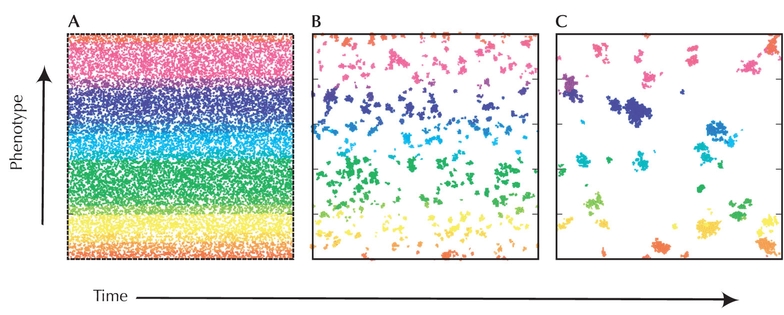

Figure WN22.2. “Descent with modification” leads to phenotypic clustering. (A) Initially, a population of individuals is randomly spread across the space of possible phenotypes, represented here by a two-dimensional square. Over time, individuals reproduce and change phenotype by random mutation, and clusters of distinct phenotypes form (B,C). This clustering, produced by random diffusion of reproducing individuals, was pointed out by Felsenstein (1975) and is known as the “pain in the torus.” The phenomenon was rediscovered by Young et al. (2001). Both these papers assume movement through actual space, not phenotypic space, but the principle is the same. (Reprinted from Fig. 1 of Young et al. 2001. http://www.nature.com.)
| © 2007-2010 by Cold Spring Harbor Laboratory Press. All rights reserved. |
| The reproduction, modification, storage in a retrieval system, or retransmission, in any form or by any means, electronic, mechanical, or otherwise, for reasons other than personal, noncommercial use is strictly prohibited without prior written permission. You are authorized to download one copy of the material on this Web site for personal, noncommercial use only. The material made available on this Web site is protected by United States copyright laws and is provided solely for the use of instructors in teaching their courses and assessing student learning. Dissemination or sale of any of this material, as a whole or in parts (including on the World Wide Web), is not permitted. All users of these materials and visitors to this Web site are expected to abide by these restrictions. Requests for permission for other uses of this material should be directed to Cold Spring Harbor Laboratory Press, 1 Bungtown Road, Cold Spring Harbor, NY 11724 or submitted via our World Wide Web Site at http://www.cshlpress.com/. |